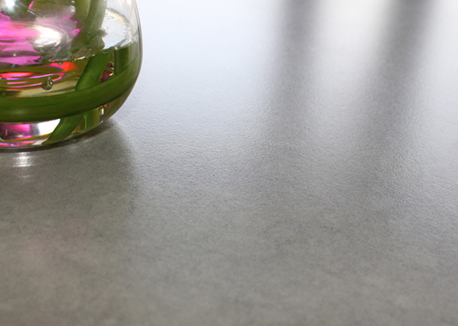Surface Value

October 9, 2012
If you had to sum up current kitchen countertop trends in a few phrases, you might use the following: durability, generational preferences, clean and simple and ice cream sundaes. When taken together, they reflect prevailing consumer attitudes about kitchen remodels (and perhaps home improvement projects in general): Sure, they’re renovating for themselves but hey, let’s not get too crazy.
PRACTICAL MATTERS
This sentiment may explain why many of the trends may seem familiar and why performance remains a key concern in purchasing decisions, even as aesthetics have assumed more of a leadership role. “The recession has changed people’s attitudes about experimentation,” said Kelly Morisseau, CMKBD, CID, a Walnut Creek, CA-based designer and author of popular industry blog Kitchen Sync. “I see quartz countertops going as strong as ever but less demand for materials like concrete and stainless steel.” In Ambler, PA, David Stimmel, of Stimmel Design Group, still uses concrete countertops in much of his work but agrees engineered stone is king, its popularity no doubt buoyed by its ease of maintenance and durability.
But all is not engineered stone. White marbles, such as Carrara and Calcutta Gold, continue to have their admirers, and thanks to a flood of lower-cost varieties from overseas, granite has not completely gone away, noted Chad Seiders, executive director of the Artisan Group. A softer, warmer alternative, solid surfacing has also regained its footing, especially among those with a taste for the sleek, contemporary and even monolithic. “It’s a better-performing material in that you can do more with it,” said Thomas Perich, North American marketing manager for surfaces at DuPont, citing advantages such as a lack of seams and the ability to create coved backsplashes, integral sinks and thick edges. “You just have a lot of flexibility.”
SAFETY IN COLORS
As to color, the selections are vast and many, yet consumer preferences still tend toward the conservative. “A lot of clients want to go for the bold colors, but in the end, they never really do,” Stimmel said. Most play it safe with earth tones, such as creams and caramels, or what Morisseau calls “ice cream sundae colors.” Summer Kath, senior director of business development and strategic partnership at Cambria USA, also sees interest in grays, browns, black and, of course, white. Not surprisingly, a recent best seller for Cosentino North America, noted Lorenzo Marquez, the company’s VP of marketing, resembles white marble.
In fact, Marquez said, “We’re finding that homeowners and designers are seeking options that offer the aesthetic of, say, a marble or granite,” a trend borne out by the latest quartz offerings from Cosentino and Cambria. Nature-inspired, the designs are rich in veining and dramatic in movement—a look favored by the older Boomer set whose kitchens are more traditional, said Morisseau. The younger, contemporary-inclined are apt to choose calmer options with smaller particulate or, if they live in cosmopolitan areas, solids, which are emerging in Europe, said Perich.
MIXING AND EDGING
Where self-expression lets loose is in the mixing of materials and colors—although that, too, can depend on geography—and the varying of countertop thicknesses, which can range from 1/2 in. to 11/2 in. to 3 in. Most industry experts agree simple edges and mitered corners are in, but some still field requests for ornate, classic treatments. Also being specified are chiseled edges on engineered and natural stone, as well as wood tops with “a naked or bark edge” that appear as if just sliced from a tree, Stimmel said. Perich has also noticed that in Europe and, to a lesser degree, on these shores, contemporary kitchens are moving toward ultra-thin countertops with virtually no edge.
Developments to watch for? Maybe. Much depends on factors beyond the realm of kitchens and baths—politics, economics, culture—and their impact on consumers’ mood. There will always be curiosity and demand for the next big thing, but if the present is any indication, form and function still go hand in hand.
More News
April 23, 2024 | Trends & Inspirations
Sustainability Report: More Education Needed for Green K&B Design
April 22, 2024 | Awards & Events, Trends & Inspirations
A Look Inside the 2024 Atlanta Homes & Lifestyles Southeastern Designer Showhouse
April 22, 2024 | KBB Collective
Top Designer Shares Favorite KBIS 2024 Products
April 22, 2024 | Trends & Inspirations
Survey: Nearly Half of Homeowners Invest in Green Plumbing
April 21, 2024 | Business
ADJ Interiors Moves Offices
April 2, 2024 | Sponsored
Whirlpool Corp. Brings Purposeful Innovation Home